The Gnarlybird
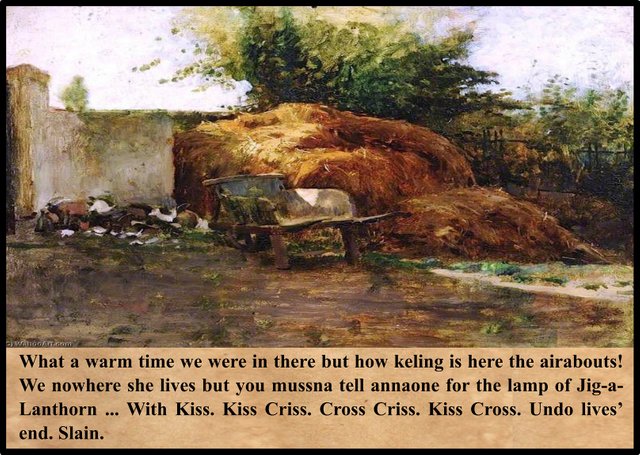
As I have said several times before, the opening chapter of Finnegans Wake is preludial. If Finnegans Wake were an opera, this chapter would be the overture that is played before the curtain rises. Everything in this chapter should be read as a foreshadowing of some salient moment that will be played out in a subsequent chapter. The Museyroom Episode, which we have just concluded, foreshadows The Story of How Buckley Shot the Russian General, which comprises the centrepiece of Book II, Chapter 3, The Scene in the Public.
The following section, which comprises the next four pages in The Restored Finnegans Wake, foreshadows Book I, Chapter 5 (RFW 083-099), The Mamafesta, which is essentially a commentary on ALP’s famous Letter to HCE. It also foreshadows a section of the book’s final chapter in which we finally get to hear the Letter in full—or one version of it, at any rate (RFW 481.28-485.10).
On one level, the Museyroom is the outhouse behind The Mullingar House, the pub in Chapelizod, Dublin, in which Finnegans Wake is set. So when we leave the Museyroom, we find ourselves outside in the backyard. John Gordon briefly describes The Mullingar House’s backyard thus:
... a backyard large enough to contain chickens ... and, in earlier times, a privy ... About the yard ... nothing is very surprising: there is a lawn, at least one chicken (as in the Blooms’ yard) and hence presumably a henhouse, the elm mentioned previously, and a gravel path. (Gordon 10 ... 17)
Curiously, Gordon does not mention the kitchen midden (a rubbish tip or dung heap), which plays an important role in Finnegans Wake. In fact, that chicken discovers ALP’s Letter in the kitchen midden, which is at once:
The barrow or burial mound of the dead HCE (and of all the dead in the world).
The ashpit, in the bottom of which old women are thrown out, as Molly Bloom laments (Ulysses 710).
The Lion’s Mound, a large conical artificial hill located on the Waterloo Battlefield near the place where a musket ball hit the shoulder of the Prince of Orange (the future William II of the Netherlands) and knocked him from his horse.
The Hill of Uisneach, or the traditional centrepoint (ie the navel or omphalos) of Ireland. This geographical feature lies close to the town of Mullingar in County Westmeath, so it is entirely fitting that a mound close to The Mullingar House should be identified with it.
An archaeological tell in which the pages of history can be read in strata.
The sterquilinium or dung heap maintained (or not!) by Katherine Strong in 17th-century Dublin.
The backyard in general doubles as:
A battlefield, which is just another type of history book that can be read by the experienced eye.
A bowling green, like the one in Tristram Shandy on which Uncle Toby and Corporal Trim reenact the Second Siege of Namur (1695) from the Nine Years’ War (the War of the League of Augsburg). There was once a bowling green behind The Mullingar House (Jolas 159).
The playing fields of Eton, on which the Battle of Waterloo was allegedly won.
Although the Museyroom Episode features the Battle of Waterloo and foreshadows an event at the Battle of Balaclava during the Crimean War, the backyard of The Mullingar House can be read as any battlefield, just as Stephen generalizes Pyrrhus as any general:
From a hill above a corpsestrewn plain a general speaking to his officers, leaned upon his spear. Any general to any officers. (Ulysses 24)
So the two key points to take away from this paragraph are:
We are on the field of battle after the fighting has stopped and the guns have fallen silent.
The battlefield is a text that can be read and interpreted by those who have the patience to learn its language.
The hen that is rooting amongst the kitchen midden is like the camp follower Mother Courage, who rakes through the debris of the battlefield and despoils the dead.
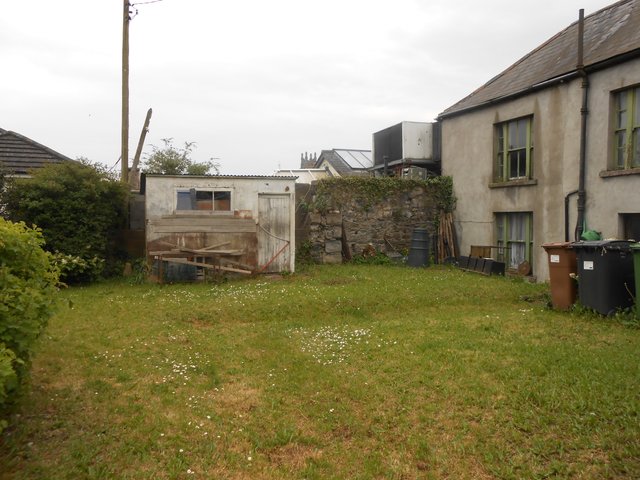
First Draft
It is often wise to take a look at the first draft of a passage of Finnegans Wake that one is trying to interpret. In this case, though, the first draft only covers two lines before it passes on to the review of the two mounds (which, in the final text, is separated from the present paragraph by more than a page of new material):
How warming to have been in there! But how keling is the airabouts here! Such reasonable weather too. The wind is so westerly. The best plan is to tour round east & north & review the two mounds. (Hayman 52)
It appears, then, that Joyce did not initially conceive of this paragraph as a foreshadowing of ALP’s Letter. It was only later, when he redrafted this section, that he introduced the hen, who represents ALP (and also Issy and Kathe). The hen’s rediscovery of the discarded Letter in the kitchen midden is equivalent to ALP’s creation of the Letter in the first place.
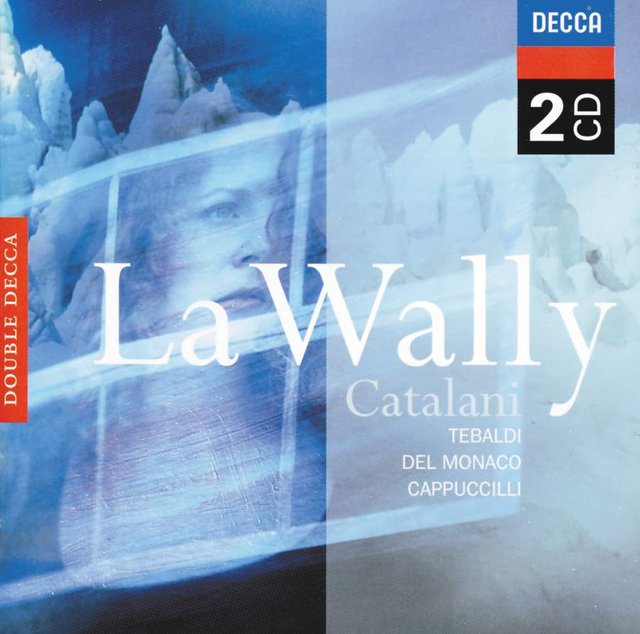
Bedrooms
Overlooking the backyard are the two bedrooms on the top floor of The Mullingar House. These are (or were at some time in the past) occupied by the children: the twin brothers Shem and Shaun, and their sister Issy. As we emerge from the Museyroom (ie the outhouse) and look up, we see Issy at her bedroom window.
Issy’s bedroom is high up on the top floor of the inn, just under its pitched roof. On some mythical or metaphorical level, then, she dwells high up among the mountain tops, on the snowy peaks of the Alps, like the heroine of Catalani’s popular opera La Wally:
| Italian | English |
|---|---|
| Ne andrò sola e lontana, Là, fra la neve bianca, n’andrò, N’andrò sola e lontana E fra le nubi d’ôr! | I will go away alone and far, There, somewhere in the white snow, I shall go, I will go away alone and far And amongst the clouds of gold! |
(Ebben! Ne andrò lontana, in Alfredo Catalani, Luigi Illica, La Wally)
This is probably why Issy is often associated in Finnegans Wake with the Rhaeto-Romanic language Romansch, a Romance language that is still spoken in parts of Switzerland. Whenever you come across words from this language, be assured that Issy is centrestage.
But in Finnegans Wake, it is often difficult to distinguish one character from another. They all have a tendency to flow into one another. Issy is simply a younger version of her mother ALP, as Kathe the cleaning lady is an older version. In this paragraph, then, the hen (gnarlybird) is ALP, Issy and also Kathe:
It’s a candlelitten houthse of a month and one windies ... And nummered quaintlymine.
The month and one and nummered quaintlymine (numbered twenty-nine) recall Issy, who is the leap-year girl, and is always associated with February 29th. But then we have:
if you can spot fifty I spy four more.
The number fifty-four is associated with ALP, because in Roman numerals fifty-four is LIV, the first three letters in Livia (ALP = Anna Livia Plurabelle).
Continuing this numerical theme, Joyce then gives us:
there’s that gnarlybird ygathering, a runalittle, doalittle, preealittle, pouralittle, wipealittle, kicksalittle, severalittle, eatalittle, whinealittle, kenalittle, helfalittle, pelfalittle gnarlybird.
Here we have the numbers one through twelve associated with the gnarlybird. In Finnegans Wake, the number twelve is generally associated with The Twelve, a jury or Greek chorus of a dozen men, who double as regular customers in HCE’s tavern and citizens at the Wake. They also represent the concept of time, there being twelve hours in a day and twelve months in a year.
So why is this number associated here with the gnarlybird? I don’t know. Joseph Campbell and Henry Morton Robinson also note the connection, but they too have no explanation to offer:
We turn from the museum to the countryside, now a silent field after battle. Round about are twelve pilfering little birds, metamorphosed duplicates of the citizens at the wake. The janitrix herself [Kate], in a bird transformation, moves through the twilight, gathering relics (as widowed Isis gathered the scattered fragments of her dismembered husband, Osiris). (Campbell et al 41)
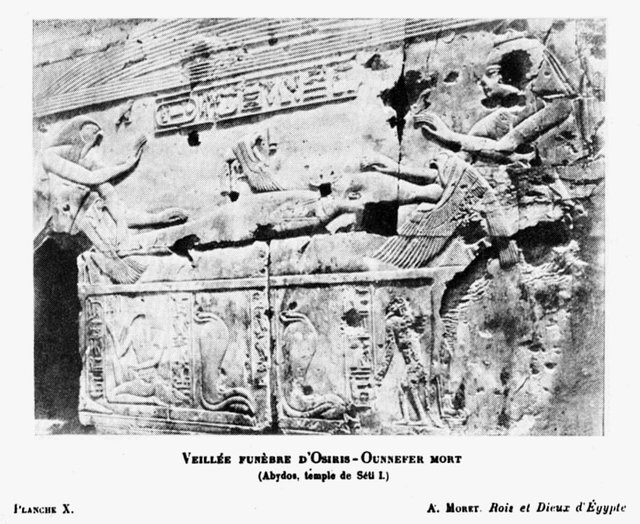
So, this paragraph anticipates the moment in Finnegans Wake when the hen will unearth ALP’s Letter from the kitchen midden (RFW 088.01 ff). That the midden doubles as HCE’s burial mound is made clear by the reference to Lumproar (French: L’Empereur, the Emperor Napoleon) lying under his red shield (wrothschields) with his sword by his side (His glav toside him). In the Museyroom HCE was Wellington, while his Oedipal sons took the role of Napoleon. But Finnegans Wake is cyclical: Oedipus kills his father Laius, becomes the new Laius, only to be killed in his turn by the new Oedipus. Wellington and Napoleon are two sides of the same coin.
Something similar can be said about the character Thon, who is introduced in this paragraph. Thon or Thonar was the name of a pagan god once worshipped by the Angles and Saxons in England and on the Continent. As his name means “thunder”, he has been equated with the Scandinavian god of thunder Thor. In Finnegans Wake, thunder is usually associated with HCE, so Thon = HCE. But Thon sounds quite like Shaun, which suggests that Thon also represents HCE’s eldest son and heir, who will one day become the new HCE. So this passage can read as a description of both the relationship between ALP and her husband HCE and that between Issy and her brother Shaun. In Egyptian mythology, Osiris was both the husband and the brother of Isis.
In passing, note how this paragraph seems to divert our attention away from the great battles on which the history of the world turns. Here we are more concerned with domestic matters in The Mullingar House. In an earlier article, I suggested that Finnegans Wake could be summed up in a nutshell thus:

It is only to be expected, therefore, that the historic account of the Battle of Waterloo should give way to a scene of simple domesticity. As the artist Carol Wade has commented:
Notice the shift in language as we move from the historic to the domestic. The domestic is often one of gentle contrasts: “then...now”, “High Downadown.” These contrasts—and the apparent separation of the domestic from the historic (as we have learned from reading the Wake so far) is merely an illusion: then and now and will be; myth and history and individual experience—these things are inextricable in the world of the Wake. (Carol Wade, Art of the Wake)
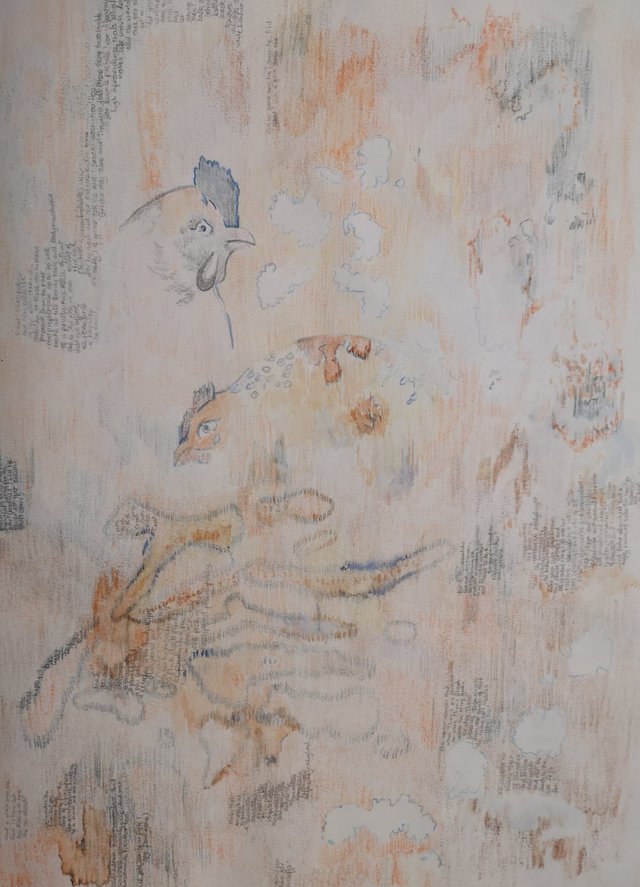
Katherine Strong
It is generally acknowledged that Joyce named ALP’s elderly cleaning lady Kathe after Katherine Strong, a real person, who lived in Dublin in the 17th century and whose job was to keep the street’s of the city clean:
In the year 1634, Sir James Carroll was appointed Mayor of the City of Dublin ... The Corporation had appointed a Woman Scavenger, Katherine Strong, a widow ... the Mayor and Corporation had made her a grant of the Tolls of the market ... she was told at the Tholsel that she was to employ six men, with six horses and carts, to collect the refuse and sweep the streets very thoroughly, load the waste matter on the carts, and remove it to well outside the city—in fact beyond Oxmanstown Green [in the vicinity of the modern Stoneybatter]. (Fraser 143)
By all accounts, Strong did not take her duties seriously. She dismissed four of her six employees with their horses and carts. She and her two remaining assistants proceeded to enrich themselves at the expense of the city. Strong abused her position of authority by extorting exorbitant tolls from the city’s labourers. She even had a brass “hat” made for herself, which she would fill with her tithe of local produce—fruit, vegetables, grain, etc. The streets, meanwhile, remained “foul and offensive” (Fraser 143). Any dung or refuse that she and her associates did pick up was promptly dumped into the River Liffey. When she remarried, her second husband, a merchant called Thomas White, must have expected her to retire from business, but her position was much too lucrative to consider taking any such step.
Later in Finnegans Wake, Joyce actually refers to K explicitly as Kate Strong (tip!), a widow (RFW 063.30).
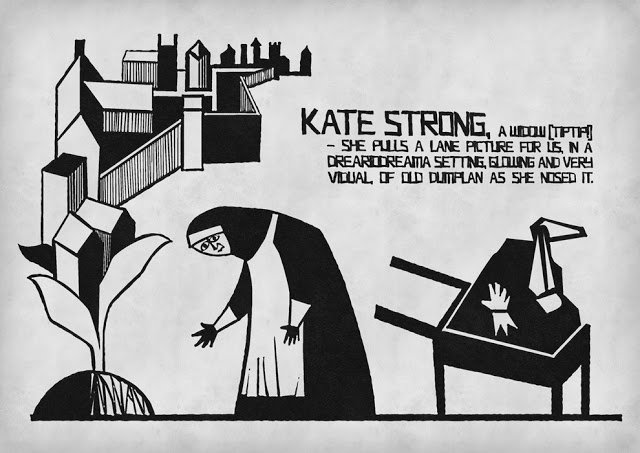
Letter Siglum
Finnegans Wake is a complex novel in which Joyce weaves an intricate tapestry out of just a handful of different threads. In order to keep track of the book’s various characters and motifs, he employed in his notes a series of signs—or sigla, as they are generally known to Wakean scholars. Some of these sigla even found their way into the published text (see, for example, RFW 230.F4). These sigla include the dramatis personae of the novel: HCE, ALP, Shem, Shaun, Issy, the Four Old Men, the Twelve and Issy’s companions (the twenty-eight Rainbow Girls) all have their own sigla.
There are also a few sigla for abstract ideas or inanimate objects, and among these is one that represents ALP’s Letter. But it is important to understand that the Letter siglum represents an abstract concept that goes well beyond the physical piece of paper on which the Letter is written, or even the text that comprises the Letter. The Letter is just one manifestation of a much more complex amalgam, to borrow a phrase from Roland McHugh. In the opening chapter of his brief work The Finnegans Wake Experience, McHugh discusses the kitchen midden in the backyard of HCE’s inn (‘the burial mound’), where the hen uncovers ALP’s Letter:
From numerous examples throughout the book, we can state definitively that the burial mound we have just discussed, and the letter which is unearthed from it, are both part of the same complex amalgam, which further includes all Wakean notions of buildings and cities. These things are ultimately containers of [HCE], and whether they are real containers of his body or verbal containers of his name they are indifferently represented in Joyce’s manuscripts by the siglum . (McHugh 1981:18)

This is illuminating. Now it becomes clear how Joyce can use the same language to describe a mound of rubbish and a piece of writing. In Finnegans Wake, the kitchen midden is HCE’s burial mound, and the Letter is a text about HCE. Both, therefore, are containers of HCE. And, so, in the dream world of Finnegans Wake they are identical. In fact, the siglum manifests in many different concrete forms throughout the book. Here are just a few examples:
- The puzzle-quilt that covers the landlord of The Mullingar House as sleeps
- The four-poster bed, in which he sleeps
- The square bedroom, in which the bed lies
- The Mullingar House, in which the bedroom is located
- Chapelizod
- Dublin
- Ireland
- The coffin (RFW 053.24 ff) in which HCE is buried
- Lough Neagh, in which the coffin is buried
- The burial mound, in which HCE is also entombed
- ALP’s Letter
- The Book of Kells
- The Egyptian Book of the Dead
- Finnegans Wake itself
One is reminded of the young Stephen Dedalus’s address in A Portrait of the Artist as a Young Man:
In another valuable work of his, The Sigla of Finnegans Wake, McHugh adds:
[ALP’s] letter is ultimately all writings, particularly FW itself. If it is identical with the cosmic egg, we may perhaps include both concepts in the siglum ,which Joyce said ‘stands for the title but I do not wish to say it yet until the book has written more of itself.’ [Footnote: Letters I, 213.] (McHugh 1976:113)
Elsewhere in the same work, McHugh notes:
Kate Strong was indeed a widow, but remarried with the merchant Thomas White thus permitting K and S [HCE’s elderly Manservant] in FW, theoretically at least, to be conjoined. Her two assistants, whose names suggest [Shem] and [Shaun], were James Bellewe and John Butcher. The ‘filthdump near the Serpentine’ is of course : affinities between K and [ALP] are thereby set up ...
The principal function of K in FW is the building and maintenance of , either as middenheap or waxworks. She also carries a message from [ALP] to [HCE] [RFW 256.38 ff] and finds him on the stairs late at night [RFW 433.17 ff]. (McHugh 1976:123)
As we shall see in subsequent paragraphs and in Chapter I.5, much of what Joyce writes concerning ALP’s Letter makes most sense when it is understood to be referring first and foremost to the text of Finnegans Wake itself. Indeed, the hen raking through the detritus of the kitchen midden—the spoils of war—in search of needful things is a metaphor for the reader _ sifting through the text of _Finnegans Wake in search of meaning.
Over the past seventy years, many commentators have been quick to dismiss Finnegans Wake as literary rubbish. It is curious, then, to discover, that Joyce himself was the first to equate his crowning masterpiece with a pile of rubbish.
References
- Joseph Campbell, Henry Morton Robinson, Edmund L Epstein (editor), A Skeleton Key to Finnegans Wake, New World Library, Novato CA (2005)
- A M Fraser, Katherine Strong: A Woman of Old Dublin, Dublin Historical Record, Volume 17, Number 4 (September 1962), pp 143-146, Old Dublin Society, Dublin (1962)
- John Gordon, Finnegans Wake: A Plot Summary, Syracuse University Press, Syracuse NY (1986)
- David Hayman, A First-Draft Version of Finnegans Wake, University of Texas Press, Austin TX (1963)
- Maria Jolas, A James Joyce Yearbook, Transition Press, Paris (1949)
- James Joyce, Ulysses, Shakespeare & Company, Paris (1922)
- James Joyce, Finnegans Wake, The Viking Press, New York (1958, 1966)
- Roland MgHugh, The Sigla of Finnegans Wake, University of Texas Press, Austin TX (1976)
- Roland McHugh, The Finnegans Wake Experience, University of California Press, Berkeley CA (1981)
- Danis Rose, John O’Hanlon, The Restored Finnegans Wake, Penguin Classics, London (2012)
Image Credits
- The Dung Heap: Charles Gogin (artist), Public Domain
- La Wally: © 2002-19 Presto Classical Limited, Fair Use
- Isis Reconstructs the Body of Osiris: Alexandre Moret, Public Domain
- The Gnarlybird: © Carol Wade (artist), Fair Use
- Kate Strong: © 2010 Stephen Crowe, Fair Use
Useful Resources
- Joyce Tools
- FWEET
- The James Joyce Scholars’ Collection
- FinnegansWiki
- James Joyce Digital Archive
- Annotated Finnegans Wake (with Wakepedia)
- From Swerve of Shore to Bend of Bay
- Art of the Wake

Excellent history and very nice article.
Thanks for share this post .....
Congratulations @harlotscurse! You have completed the following achievement on the Steem blockchain and have been rewarded with new badge(s) :
You can view your badges on your Steem Board and compare to others on the Steem Ranking
If you no longer want to receive notifications, reply to this comment with the word
STOPTo support your work, I also upvoted your post!
Vote for @Steemitboard as a witness to get one more award and increased upvotes!
love your post really
very nice bloog writing bro..keep it up.